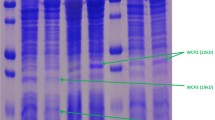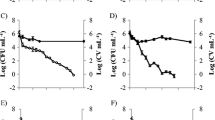Abstract
Glucose-inhibited division (GidA) protein is widely distributed in nature, and is highly conserved among bacteria and eukarya. In our previous study, a gidA mutant was attenuated in both in vitro and in vivo models of Salmonella infection. Furthermore, deletion of gidA resulted in a marked reduction in the expression of many virulence genes and proteins, suggesting a role for GidA in the regulation of Salmonella virulence. In this study, the effect of different environmental conditions (glucose, EDTA, and pH 5) on GidA expression in Salmonella was examined. Transcriptional analysis using real-time RT-PCR and a β-galactosidase assay, displayed no differences in gidA transcription and promoter activity in different environmental conditions. Conversely, semiquantitative Western blot analysis revealed a significant increase in the GidA expression in Salmonella when grown under different environmental conditions. Salmonella in vitro virulence assays showed an increased virulence potential in the environmental conditions correlating to the increase in GidA expression. Together, our data indicate that GidA expression is modulated under different environmental conditions which correlate to increased Salmonella in vitro virulence.




Similar content being viewed by others
References
Adler J, Templeton B (1967) The effect of environmental conditions on the motility of Escherichia coli. J Gen Microbiol 46:175–184
Bajaj V, Lucas RL, Hwang C et al (1996) Co-ordinate regulation of Salmonella typhimurium invasion genes by environmental and regulatory factors is mediated by control of hilA expression. Mol Microbiol 22:703–714
Bregeon D, Colot V, Radman M et al (2001) Translational misreading: a tRNA modification counteracts a +2 ribosomal frameshift. Genes Dev 15:2295–2306
Cho KH, Caparon MG (2008) tRNA modification by GidA/MnmE is necessary for Streptococcus pyogenes virulence: a new strategy to make live attenuated strains. Infect Immun 76:3176–3186
Elseviers D, Petrullo LA, Gallagher PJ (1984) Novel E. coli mutants deficient in biosynthesis of 5-methylaminomethyl-2-thiouridine. Nucleic Acids Res 12:3521–3534
Ernst RK, Dombroski DM, Merrick JM (1990) Anaerobiosis, type 1 fimbriae, and growth phase are factors that affect invasion of HEp-2 cells by Salmonella typhimurium. Infect Immun 58:2014–2016
Foster JW, Spector MP (1995) How Salmonella survive against the odds. Annu Rev Microbiol 49:145–174
Gaal T, Ross W, Estrem ST et al (2001) Promoter recognition and discrimination by EsigmaS RNA polymerase. Mol Microbiol 42:939–954
Gupta R, Gobble TR, Schuster M (2009) GidA post-transcriptionally regulates rhl quorum sensing in Pseudomonas aeruginosa. J Bacteriol 191:5785–5792
Gustilo EM, Vendeix FA, Agris PF (2008) tRNA’s modifications bring order to gene expression. Curr Opin Microbiol 11:134–140
Hersh D, Monack DM, Smith MR et al (1999) The Salmonella invasin SipB induces macrophage apoptosis by binding to caspase-1. Proc Natl Acad Sci USA 96:2396–2401
Jones BD, Ghori N, Falkow S (1994) Salmonella typhimurium initiates murine infection by penetrating and destroying the specialized epithelial M cells of the Peyer’s patches. J Exp Med 180:15–23
Lee CA, Falkow S (1990) The ability of Salmonella to enter mammalian cells is affected by bacterial growth state. Proc Natl Acad Sci USA 87:4304–4308
Livak KJ, Schmittgen TD (2001) Analysis of relative gene expression data using real-time quantitative PCR and the 2(-delta delta C(T)) method. Methods 25:402–408
Mattick KL, Jorgensen F, Legan JD et al (2000) Survival and filamentation of Salmonella enterica serovar Enteritidis PT4 and Salmonella enterica serovar Typhimurium DT104 at low water activity. Appl Environ Microbiol 66:1274–1279
Miao EA, Alpuche-Aranda CM, Dors M et al (2006) Cytoplasmic flagellin activates caspase-1 and secretion of interleukin 1beta via Ipaf. Nat Immunol 7:569–575
Mikheil DM, Shippy DC, Eakley NM et al (2012) Deletion of gene encoding methyltransferase (gidB) confers high-level antimicrobial resistance in Salmonella. J Antibiot (Tokyo) 65:185–192
Miller J (1972) Experiments in molecular genetics. Cold Spring Harbor Laboratory Press, Cold Spring Harbor
Moukadiri I, Prado S, Piera J et al (2009) Evolutionarily conserved proteins MnmE and GidA catalyze the formation of two methyluridine derivatives at tRNA wobble positions. Nucleic Acids Res 37:7177–7193
Nazario M (1972) Different arginine transfer ribonucleic acid species prevalent in shaken and unshaken cultures of Neurospora. J Bacteriol 112:1076–1082
Polson A, Von Wechmar MB, Van Regenmortel MH (1980) Isolation of viral IgY antibodies from yolks of immunized hens. Immunol Commun 9:475–493
Schiemann DA, Shope SR (1991) Anaerobic growth of Salmonella typhimurium results in increased uptake by Henle 407 epithelial and mouse peritoneal cells in vitro and repression of a major outer membrane protein. Infect Immun 59:437–440
Schmitt CK, Ikeda JS, Darnell SC et al (2001) Absence of all components of the flagellar export and synthesis machinery differentially alters virulence of Salmonella enterica serovar Typhimurium in models of typhoid fever, survival in macrophages, tissue culture invasiveness, and calf enterocolitis. Infect Immun 69:5619–5625
Sha J, Kozlova EV, Fadl AA et al (2004) Molecular characterization of a glucose-inhibited division gene, gidA, that regulates cytotoxic enterotoxin of Aeromonas hydrophila. Infect Immun 72:1084–1095
Shi R, Villarroya M, Ruiz-Partida R et al (2009) Structure-function analysis of Escherichia coli MnmG (GidA), a highly conserved tRNA-modifying enzyme. J Bacteriol 191:7614–7619
Shippy DC, Eakley NM, Bochsler PN et al (2011) Biological and virulence characteristics of Salmonella enterica serovar Typhimurium following deletion of glucose-inhibited division (gidA) gene. Microb Pathog 50:303–313
Shippy DC, Eakley NM, Lauhon CT et al (2013) Virulence characteristics of Salmonella following deletion of genes encoding the tRNA modification enzymes GidA and MnmE. Microb Pathog 57:1–9
Shippy DC, Fadl AA (2012) Immunological characterization of a gidA mutant strain of Salmonella for potential use in a live-attenuated vaccine. BMC Microbiol 12:286
Shippy DC, Heintz JA, Albrecht RM et al (2012) Deletion of glucose-inhibited division (gidA) gene alters the morphological and replication characteristics of Salmonella enterica serovar Typhimurium. Arch Microbiol 194:405–412
Tartera C, Metcalf ES (1993) Osmolarity and growth phase overlap in regulation of Salmonella typhi adherence to and invasion of human intestinal cells. Infect Immun 61:3084–3089
Trott DL, Hellestad EM, Yang M et al (2008) Additions of killed whole cell bacteria preparations to Freund complete adjuvant alter laying hen antibody response to soluble protein antigen. Poult Sci 87:912–917
Von Meyenburg K, Jorgensen BB, Nielsen J et al (1982) Promoters of the atp operon coding for the membrane-bound ATP synthase of Escherichia coli mapped by Tn10 insertion mutations. Mol Gen Genet 188:240–248
Yim L, Moukadiri I, Bjork GR et al (2006) Further insights into the tRNA modification process controlled by proteins MnmE and GidA of Escherichia coli. Nucleic Acids Res 34:5892–5905
Acknowledgments
The authors would like to express their gratitude to Dr. Richard Gourse, the University of Wisconsin-Madison, for providing the E. coli RLG3499 strain, as well as acknowledge the assistance provided during the densitometry analysis. This study was supported by a Grant from the USDA Hatch Fund.
Author information
Authors and Affiliations
Corresponding author
Additional information
Jaclyn M. Rehl and Daniel C. Shippy contributed equally to this study.
Rights and permissions
About this article
Cite this article
Rehl, J.M., Shippy, D.C., Eakley, N.M. et al. GidA Expression in Salmonella is Modulated Under Certain Environmental Conditions. Curr Microbiol 67, 279–285 (2013). https://doi.org/10.1007/s00284-013-0361-2
Received:
Accepted:
Published:
Issue Date:
DOI: https://doi.org/10.1007/s00284-013-0361-2




